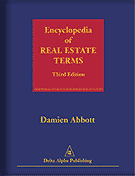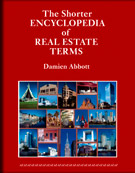abandonment
1. The act of giving up or proscribing completely. Yielding, ceding or giving up totally, especially ceding permanent control to another.
2. The voluntary relinquishment or surrender of property, or an interest in property, without any intention of resuming enjoyment or possession, or of vesting it in anyone else. The disclaiming of a right, expressly or by implication, without leaving any evidence of an intention to reclaim that right. Thus, abandonment requires two elements, an intention to relinquish a right or property and the act by which the intention is carried into effect (Roebuck v. Mecosta County Road Comm'n, 59 Mich App 128, 229 NW.2d 343, 345-6 (1975)).
The ownership of a fee title to land may be given away or sold, and it may be lost by the adverse possession; but it cannot be abandoned (East Tennessee Iron & Coal Co. v. Wiggin, 15 CCA 510, 68 F 446, 37 US 129 (6th Cir. Tenn 1895); Waldrop v. Whittington, 213 Miss 567, 57 So.2d 298 (1952); Jones v McClean (1931) 2 DLR 244 (Can)). A right to possession or use of an interest in land may be abandoned, provided there is an intention not to resume that right or interest, or some overt act or failure to act that supports that intention.
Simply not using an easement does not of itself constitute abandonment. There must be a clear intention to abandon, or an overt act that is repugnant to the right of user (Swan v Sinclair [1924] 1 Ch 254, 266, aff'd [1925] AC 227 (HL)); Zimmerman v. Young, 74 Cal App.2d 623, 169 P.2d 37 (1946); Ellis v. Brown, 177 F.2d 677 (6th Cir. Ky 1949); Gabel v. Cambruzzi, 532 Pa 584, 616 A.2d 1364, 1367 (1992); Pekarek v. Votow, 216 AD.2d 829, 628 NYS.2d 859 (1995); 28A C.J.S., Easements, § 126). For example, keeping a doorway bricked up for a number of years may not of itself amount to a sufficient indication of an intention not to reopen it; but removing a wall that contained a window, and then waiting many years before rebuilding it, shows that the beneficiary does not need the right to the light and demonstrates an intention to abandon the need for the right of light (Cook v Bath Corp'n (1868) LR 6 Eq 177, 18 LT 123; Williams v Underwood (1983) 45 P & CR 235, 256; Ernst v. Keniry, 19 AD.2d 938, 244 NYS.2d 239 (1963); Anno: 98 ALR 1291: Loss of Easement).
A lease cannot be abandoned unilaterally during its term (Colles v Evanson (1865) 19 CB (NS) 372, 19 Eng Rep 831; In Gruman v. Investors Diversified Services, Inc., 247 Minn 502, 78 NW.2d 377, 380 (1956); K & C Associates v. Airborne Freight Corp., 20 Wash App 653, 581 P.2d 1082, 1084 (1978)). However, if a tenant leaves the premises that are leased to him empty, or demonstrates a manifest intention not to occupy the premises, and then permits the landlord to re-enter and take absolute and unqualified possession of the premises, the tenancy may be said to have been abandoned; or, more precisely, the tenant has offered, and the landlord has accepted a surrender of the possession. There may be said to be a 'surrender by operation of law' (Phene v Popplewell (1862) 12 CB (NS) 334, 342, 142 Eng Rep 1171; tenBraak v. Waffle Shops, Inc., 542 F.2d 919, 924 (4th Cir. Va 1976); Atkinson v. Rosenthal, 598 NE.2d 666, 668 (Mass App Ct 1992); 51C C.J.S., L & T, § 124; 2 Powell on Real Property, § 17.05[1], 17-74). Alternatively, there may be a form of constructive eviction where the landlord takes an action that prevents the tenant's further use of the premises.
In the US, there is a considerable difference of opinion as to whether a landlord has a duty to mitigate the tenant's loss by taking steps to relet the premises after the tenant has abandoned them. In some jurisdictions, if a tenant abandons the demised premises before the end of a term and the landlord re-enters, the landlord is obliged to make reasonable efforts to relet the premises in order to minimize any claim that he may have against the tenant for past rent due (e.g. Snyder v. Ambrose, 203 Ill Dec 319, 266 Ill App.3d 163, 639 NE.2d 639, 640 (1994)). As a corollary, some jurisdictions take the view that reletting the premises amounts to accepting a surrender of the lease by the landlord, relieving the tenant of all further liability for payment of rent (e.g. Mesilla Valley Mall Co. v. Crown Industries, 111 NM 663, 808 P.2d 633 (1991)). Whereas other jurisdictions take the view that even if the premises are relet, the tenant remains liable for any loss of rental value suffered by the landlord during the remaining term of the lease (Yates v. Reid, 36 Cal.2d 383, 224 P.2d 8 (1950); Anno: 21 ALR3d 534: Damages— Mitigation by Landlord (1968); Lefrak v. Lambert, 93 Misc.2d 632, 403 NYS.2d 397 (1978); Boise Joint Venture v. Moore, 106 Or App 83, 806 P.2d (1990); Austin Hill v. Palisades Plaza, Inc., 948 SW.2d 293, 295 n. 1 (Tex 1997)—note 1 lists cases from 42 states and District of Columbia that have recognized a landlord's duty to mitigate damages in at least some situations). The Uniform Residential Landlord and Tenant Act (URLTA), which has been adopted by several states, provides that if the tenant abandons a dwelling unit, the landlord shall "make reasonable efforts to let it at a fair rental" § 4.203(c). The Model Residential Landlord-Tenant Code, § 2-308(4) contains a similar position. In California, if a tenant vacates premises the landlord has a right to declare abandonment, either by a judicial process or by notice after a period of non-payment of rent (Cal CC, § 1951.3).
Abandonment is a voluntary and wilful act and may thus be distinguished from eviction and forfeiture either of which can arise as a result of an illegal act or omission. Cf. laches, repudiation. See also escheat, estoppel, frustration, lapsed land (US), release, res nullius.
bibliographical references:
Anno: 40 ALR4th 1012: Zoning—Use Abandonment by Part Occupancy.
Anno: 84 ALR4th 183: Abandonment of Leases—Modern Cases.
Anno: 62 ALR5th 219: Private Easement—Loss by Nonuse.
Anno: 18 ALR5th 437: Rent-Free Occupancy.
1 Am.Jur.2d., Abandoned, Lost, and Unclaimed Property, §§ 1-44.
63C Am.Jur.2d., Property, § 72.
25 Am.Jur.2d., Easements and Licenses, § 112-114.
49 Am.Jur.2d., Landlord and Tenant, §§ 249-251, 295, 485.
1 Cor.Jur.Sec., Abandonment, §§ 1-12.
52A Cor.Jur.Sec., Landlord & Tenant, §§ 120-129, 477.
C.J. Berger and J.C. Williams. Land Ownership and Use (4th ed. 1997), pp. 353-367 (abandonment by tenant).
J.E. Cribbet et al. Cases and Materials on Property (7th ed. 1996), pp. 501-507 (abandonment by tenant).
2 Powell on Real Property, § 17.05 "abandonment by tenant".
3 Powell on Real Property, § 34.20 "Easement—Abandonment".
6 Powell on Real Property, § 79C.06[f] " abandonment of nonconforming use".
7 Thompson on Real Property (2d ed. 1994), § 60.08(b)(3) "Abandonment of Easements".
5 Thompson on Real Property (2d ed. 1994), § 40.11 "Abandonment of Leased Premises".
Gale on Easements (16th ed. 1997), paras. 12-19§12-74.
14 Halsbury's Laws of England, Easements (4th ed.), paras. 122-125.
3. The discontinuance of a use of land for a considerable period of time, especially a non-conforming use, so that
the use may not legally be resumed. It may be said, "the actual abandonment of a nonconforming use is fatal to its continuance", Borough of Saddle River v. Bobinski, 108 NJ Super 6, 259 A.2d 727, 733 (1969). However, there must be a clear intent to abandon that use, as well as actual cessation, not merely a discontinuance, of the use (Am.Jur.2d., Zoning and Planning, §§ 682-697;
Anno: 57 ALR3d 279: Zoning—Resumption of Nonconforming Use). A holder of a vested building permit does not lose that consent merely by a delay in construction; there must be a manifest intention to abandon the right, unless the consent was made subject to completion within a specified (and reasonable) period of time and due notice has been given but not acted on
by the permit holder. A building permit holder who has vested rights as a result of commencing construction and carrying out substantial building work, does not abrogate that right because he is obliged to cease construction due to adverse economic circumstances (Pardee Construction Co. v. California Coastal Comm'n, 95 Cal App.3d 471, 157 Cal Rptr 184 (1979)).
In English planning law, the abandonment of a use produces the result that the resumption of that use may constitute development and, therefore, requires planning permission. "[I]t is perfectly feasible in this context to describe a use as having been abandoned when one means that it has not merely been suspended for a short and determinable period, but has ceased with no intention to resume it at any particular time." Hartley v Minister of Housing and Local Government [1970] 1 QB 413, 420, 421 (CA).In this connection factors to be considered are (i) the period of time for which the use is discontinued;
(ii) whether there is any intention to re-establish the discontinued use, which may be judged from the state of the property or any elected action on the part of the party seeking to re-establish the use; and (iii) any intervening user. A new use, even though in itself temporary, tends to mitigate in favour of an indication of an intention to abandon a use. "Abandonment depends on the circumstances. If the land has remained unused for a considerable time, in such circumstances that a reasonable man might conclude that the previous use has been abandoned then [the planning authority or the Secretary of State] may hold it to have been abandoned&q Hartley v Minister of Housing and Local Government, supra at 420. Or, "when a use has ceased with no intention to resume it at any particular time … then as a matter of fact the use has ceased." supra at 420. Planning permission once granted endures for the benefit of land, and any person who holds an interest in the land at any point in time, unless any condition provides to the contrary. However, a planning permission may be revoked or modified (subject to payment of compensation) (Town and Country Planning Act 1990, 75(1)). It may also be granted for a limited duration, but cannot be abandoned. However, the benefit of a particular planning permission may be lost when, pursuant to a subsequent planning permission, a landowner builds in accordance with that permission and by such action makes the former permission intractable (Pioneer Aggregates (UK) Ltd v Secretary of State for the Environment [1985] AC 132, [1984] 2 All ER 358 (HL)). Nonetheless, any planning consent that is granted must be begun within five years, or such other period as may be prescribed by the authority that granted the consent; and work that is authorised by such a consent generally must be completed within a prescribed time limit. A failure to meet such conditions may be considered a loss or abandonment of that consent and require a reversion to the previously authorised user (1990 Act, ss. 91-96; Sir Desmond Heap, An Outline of Planning Law (11th ed. 1996), pp. 179-186). See also completion notice(Eng).
4. The act of relinquishing damaged property or salvage to an insurer with the aim of claiming a total loss. See also subrogation.
|




